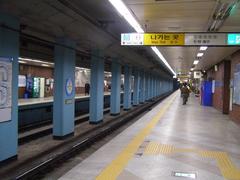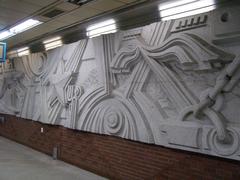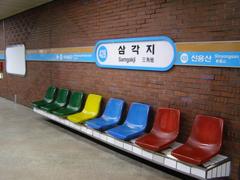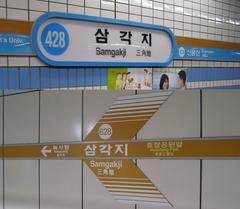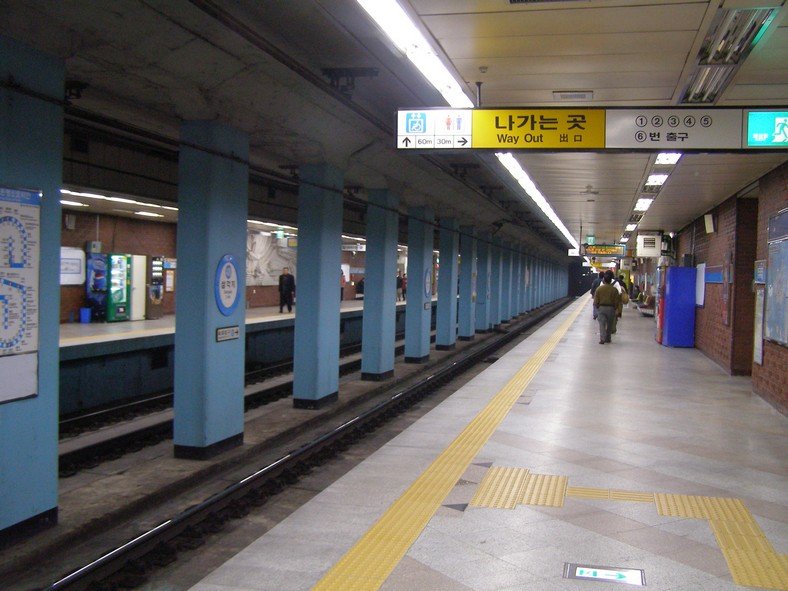
Samgakji Station: Visiting Hours, Tickets, and Guide to Seoul’s Historical Sites
Date: 14/06/2025
Introduction: Samgakji Station’s Role in Seoul’s Cultural and Historical Landscape
Nestled in the heart of Seoul’s Yongsan district, Samgakji Station is far more than a transit interchange for Lines 4 and 6; it serves as a living intersection of Korean history, memory, and modern multiculturalism. Named after the “triangle intersection” it anchors, Samgakji has historically linked central Seoul with military and cultural districts, making it a crucial gateway for both everyday commuters and visitors seeking to explore the city’s storied past and vibrant present. Within minutes of the station lies the War Memorial of Korea, a globally significant museum complex that stands as a testament to Korea’s military history and its ongoing hope for peace and reconciliation. This comprehensive guide will help you maximize your visit—offering details on Samgakji Station’s facilities, nearby historical sites, traveler tips, and the broader cultural context that makes this area a must-see destination in Seoul (Korea Tour Information; The Soul of Seoul; Seoul Selection Magazine).
Table of Contents
- Overview: Why Visit Samgakji Station?
- Historical Background and Development
- Exploring the War Memorial of Korea
- Cultural Significance: Symbols and Spaces
- Visitor Information: Hours, Tickets, and Accessibility
- Samgakji Station Facilities and Connectivity
- Local Attractions and Experiences
- Frequently Asked Questions (FAQ)
- Conclusion and Visitor Recommendations
- Sources and Further Reading
1. Overview: Why Visit Samgakji Station?
Samgakji Station is a gateway to understanding Korea’s modern identity. Whether you’re a history enthusiast, foodie, or urban explorer, the area offers a seamless blend of education, reflection, and multicultural experiences. Its proximity to the War Memorial of Korea and the cosmopolitan Itaewon district ensures a rich itinerary for any visitor.
2. Historical Background and Development
Samgakji Station’s Origins
The station opened in 1985 (Line 4) and expanded in 2000 (Line 6), quickly becoming a vital transfer point due to its strategic location. The “triangle intersection” once marked a critical junction for military logistics, given its proximity to the Yongsan Garrison and central Seoul. Today, it stands as a symbol of Korea’s transition from war-torn past to dynamic metropolis (Korea Tour Information).
3. Exploring the War Memorial of Korea
About the Memorial
Located just five minutes from Samgakji Station’s Exit 12, the War Memorial of Korea is the largest war memorial museum in the world. Opened in 1994 on the grounds of the former army headquarters, it hosts over 13,000 artifacts spread across seven exhibition halls and expansive outdoor grounds. The museum chronicles Korea’s military history from ancient times through the Korean War and into the present day (Wander with Jin; The Soul of Seoul).
What to See
- Statue of Brothers: This poignant statue outside the memorial depicts a South Korean soldier embracing his younger North Korean brother, symbolizing the tragedy of war and the hope for reunification (Visit Seoul).
- Outdoor Exhibits: Military vehicles, aircraft, and artillery are on display, offering an immersive look at the machinery of modern warfare.
- Clock Tower of Peace & Gardens: Peaceful spaces designed for reflection, featuring symbolic sculptures and memorials (Wander with Jin).
4. Cultural Significance: Symbols and Spaces
The Samgakji area is rich with cultural and symbolic landmarks:
- Statue of Brothers: Emblematic of national reconciliation.
- Bae Ho’s “Samgakji” Song Statue: Celebrates the 1967 pop hit, contributing to the station’s unique place in Korean pop culture (Seoul Selection Magazine).
- Veterans’ Monuments: Smaller installations commemorate Korean and UN soldiers.
The multicultural flavor of nearby Itaewon, shaped by decades of international presence, adds a cosmopolitan layer to the district (Korea Tour Information).
5. Visitor Information: Hours, Tickets, and Accessibility
War Memorial of Korea
- Hours: Tuesday–Sunday, 9:30 AM–6:00 PM (last admission 5:00 PM); closed Mondays and select holidays.
- Admission: Free for all visitors.
- Guided Tours: Available in multiple languages; check the official site for times.
- Accessibility: Fully accessible with ramps, elevators, and accessible restrooms.
Samgakji Station
- Operating Hours: Approximately 5:30 AM–midnight.
- Tickets: No entry ticket required beyond regular subway fare. T-Money cards are recommended for convenience and discounted fares (The Broke Backpacker).
- Facilities: Elevators, tactile paving, accessible restrooms, and baby changing stations ensure inclusivity for all travelers.
6. Samgakji Station Facilities and Connectivity
Station Layout
- Platforms: Line 4 and Line 6 operate on separate underground levels; transfers are seamless with clear bilingual signage.
- Exits: 14 numbered exits; Exit 12 leads to the War Memorial, Exit 14 to Daegutang Alley, and others to Itaewon-ro and bus stops (Seoul Selection Magazine).
- Amenities: Convenience stores, rest areas, cultural displays, and coin lockers for luggage storage.
- Wi-Fi: Free public Wi-Fi and mobile charging stations.
Connectivity
- Subway: Direct lines to Seoul Station, Myeongdong, Dongdaemun, Itaewon, and more.
- Bus: Multiple city bus routes stop nearby; city tour buses include Samgakji (Lonely Planet).
- Taxi/Ride-Hailing: Taxi stands at major exits and Kakao Taxi app support.
7. Local Attractions and Experiences
Historical Sites
- War Memorial of Korea: See above.
- Yongsan Garrison: The former US military headquarters, now being redeveloped as a public park.
- Samgakji Park: Small green space with war memorials.
Food and Culture
- Jjimdak Alley: Near Exit 8, renowned for Andong-style braised chicken.
- Samgyeopsal and Naengmyeon: Abundant grill houses and noodle shops.
- Markets: Namdaemun Market is a short subway ride away (Namdaemun Market).
Art and Entertainment
- Local Galleries: Small independent venues host exhibitions and performances.
- Theaters: National Theater of Korea is a few stops away (National Theater of Korea).
Pop Culture
- “Return to Samgakji” Statue: Honors the iconic song and its place in Korean memory.
8. Frequently Asked Questions (FAQ)
Q: What are Samgakji Station’s operating hours?
A: 5:30 AM to midnight daily.
Q: Is there an entrance fee for the War Memorial?
A: No, admission is free.
Q: Are guided tours offered at the War Memorial?
A: Yes, in multiple languages; check with the information desk or official site.
Q: Is the station accessible for disabled visitors?
A: Yes, with elevators, tactile paving, and accessible restrooms.
Q: What’s the best way to buy subway tickets?
A: Use a T-Money card for convenience and discounts; available at station kiosks and convenience stores.
9. Conclusion and Visitor Recommendations
Samgakji Station stands at the crossroads of Seoul’s historical, cultural, and modern identity. It offers more than just metro connectivity—it provides visitors with unique opportunities for reflection, education, and immersion in local culture. From the moving exhibits of the War Memorial of Korea to the vibrant dining alleys and multicultural neighborhoods, a visit to Samgakji is essential for anyone seeking to understand the spirit of Seoul. To make the most of your visit, travel during spring or autumn, take advantage of guided tours and audio guides, and use navigation aids such as Naver Map or KakaoMap for real-time local information.
For the latest tips and resources, download the Audiala app and follow our social media channels.
Sources and Further Reading
- Korea Tour Information
- Wander with Jin
- The Soul of Seoul
- Visit Seoul
- Seoul Selection Magazine
- Lonely Planet
- Wapiti Travel
- Seoul Korea Asia
